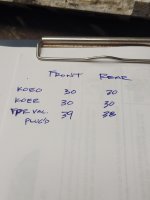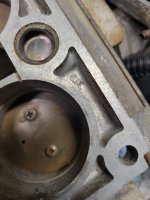ok i think ive got all this typed up correctly:
B0:
1. check for adequate fuel supply
2. key off
3. install fuel pressure gauge
4. install test lead to FP lead of VIP test connector (** personal note ** this is the same test connector you use to check the check engine codes.)
5. turn key to RUN position
6. ground test lead to run fuel pump (** personal note ** all this part does is to tell the fuel pump to run continuously for the test. this part is not necessary, as you could just turn the key on while watching the gauge.)
7. refer to fuel pressure specification table and check to determine if pressure is within acceptable limits. was pressure within acceptable limits? yes > GO to B4, no > GO to B1
B1:
1. pressure low but greater than 3 PSI? (indicates fuel pump is running but not enough pressure) yes > GO to B2, no > GO to B3
B2:
1. plugged fuel filter (replace filter and check again for proper pressure)
2. kinked/restricted fuel lines (visual inspection)
3. low voltage to fuel pump (should be within 0.5 volts of battery voltage at connector)
4. disconnect return fuel line and note if fuel is being returned during this low pressure condition. if fuel is being returned, replace pressure regulator. If service was required and made > RETURN to B0, if no service was required, > replace fuel pump and RETURN to B0.
B3 (electrical circuit check):
1. inertia switch open? (reset switch as required)
2. wiring at fuel pump/tank connector loose or open?
3. fuel pump ground connection at chassis loose or defective?
4. improper fuel pump relay operation? (should operate when FP (test) lead is grounded with ignition key in RUN position)
5. EEC relay not operating if fuel pump relay doesnt operate? service all electrical problems and > RETURN to B0, if no electrical defects have been found, and pump still wont run > REPLACE pump and RETEST per step B0.
B4 (check valve test):
1. remove ground from test lead and note pressure on gauge. pressure should remain within 2 PSI for 3 minutes after lead is ungrounded. is pressure within 2 psi? yes > GO to B6, no > GO to B5
B5:
1. fuel lines or connectors leaking?
2. disconnect fuel return line and plug engine side. momentarily activate fuel pump by grounding test lead. raise pressure to approximate operating pressure. repeat step B4. if pressure holds, replace regulator and repeat test B4. if service was made > GO to Step B0. if no problems were found, > Replace fuel pump and GO to step B0. if unit still fails step B4, there may be a leaking fuel injector or rail. CORRECT these problems and GO to step B4.
B6 (engine on test):
1.if engine is EFI, disconnect and plug the vacuum line connected to the pressure regulator.
2. start engine and run at idle. fuel pressure should be as indicated in chart for key on, engine off. Is the pressure in spec for key on, engine off? yes > GO to B8, no > GO to B7.
B7 (idle engine repair):
1. fuel filter restricted? (replace)
2. improper fuel regulator adjustment? (** personal note ** ignore this step, pressure regulator is not adjustable)
3. fuel line restricted?
4. improper voltage to fuel pump? (battery voltage at pump connections) if defect has been found and serviced > GO to B0, if no defect is found > replace fuel pump and GO to B0
B8 (high speed test):
1. with engine running at idle and vacuum line disconnected if necessary from step B6, note fuel rail pressure.
2. rapidly accelerate engine and watch fuel pressure. does pressure remain within 5 psi of starting pressure? yes > fuel pump is ok. if problem persists, CONSULT other parts of the manual. DISCONNECT test connections and RECONNECT vacuum lead if removed for test, no > GO to B7. (personal note if vacuum line is connected to regulator, pressure should increase when engine revs increase, if disconnected pressure should decrease when engine revs increase)



